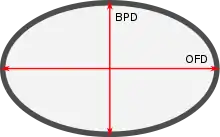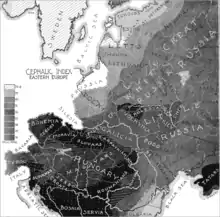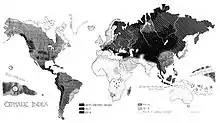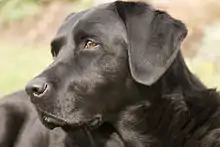Cephalic index
The cephalic index or cranial index is the ratio of the maximum width (biparietal diameter or BPD, side to side) of the head of an organism (human or animal) multiplied by 100 divided by its maximum length (occipitofrontal diameter or OFD, front to back). The index is also used to categorize animals, especially dogs and cats.

Historic use in anthropology
Early anthropology

The cephalic index was widely used by anthropologists in the early 20th century to categorize human populations. It is now mainly used to describe individuals' appearances and for estimating the age of fetuses for legal and obstetrical reasons.
The cephalic index was defined by Swedish professor of anatomy Anders Retzius (1796–1860) and first used in physical anthropology to classify ancient human remains found in Europe. The theory became closely associated with the development of racial anthropology in the 19th and early 20th centuries, when prehistorians attempted to use ancient remains to model population movements in terms of racial categories. Carleton S. Coon also used the index in the 1960s.

Humans are characterized by having either a dolichocephalic (long-headed), mesaticephalic (moderate-headed), or brachycephalic (short-headed) cephalic index or cranial index.
Indices

Cephalic indices are grouped as in the following table:
| Females | Males | Scientific term | Meaning | Alternative term |
|---|---|---|---|---|
| < 75 | < 75.9 | dolichocephalic | 'long-headed' | |
| 75 to 83 | 76 to 81 | mesaticephalic | 'medium-headed' | mesocephalic; mesocranial |
| > 83 | > 81.1 | brachycephalic | 'short-headed' | brachycranial |
Technically, the measured factors are defined as the maximum width of the bones that surround the head above the supramastoid crest (behind the cheekbones), and the maximum length from the most easily noticed part of the glabella (between the eyebrows) to the most easily noticed point on the back part of the head.
Controversy
The usefulness of the cephalic index was questioned by Giuseppe Sergi, who argued that cranial morphology provided a better means to model racial ancestry.[1] Also, Franz Boas studied the children of immigrants to the United States in 1910 to 1912, noting that the children's cephalic index differed significantly from their parents', implying that local environmental conditions had a significant impact on the development of head shape.[2]
Boas argued that if craniofacial features were so malleable in a single generation, then the cephalic index was of little use for defining race and mapping ancestral populations. Scholars such as Earnest A. Hooton continued to argue that both environment and heredity were involved. Boas did not himself claim it was totally plastic.
In 2002, a paper by Sparks and Jantz re-evaluated some of Boas' original data using new statistical techniques and concluded that there was a "relatively high genetic component" of head shape.[3] Ralph Holloway of Columbia University argues that the new research raises questions about whether the variations in skull shape have "adaptive meaning and whether, in fact, normalizing selection might be at work on the trait, where both extremes, hyperdolichocephaly and hyperbrachycephaly, are at a slight selective disadvantage."[2]
In 2003, anthropologists Clarence C. Gravlee, H. Russell Bernard, and William R. Leonard reanalyzed Boas' data and concluded that most of Boas' original findings were correct. Moreover, they applied new statistical, computer-assisted methods to Boas' data and discovered more evidence for cranial plasticity.[4] In a later publication, Gravlee, Bernard and Leonard reviewed Sparks' and Jantz' analysis. They argue that Sparks and Jantz misrepresented Boas' claims, and that Sparks' and Jantz' data actually support Boas. For example, they point out that Sparks and Jantz look at changes in cranial size in relation to how long an individual has been in the United States in order to test the influence of the environment. Boas, however, looked at changes in cranial size in relation to how long the mother had been in the United States. They argue that Boas' method is more useful, because the prenatal environment is a crucial developmental factor.[4]
Jantz and Sparks responded to Gravlee et al., reiterating that Boas' findings lacked biological meaning, and that the interpretation of Boas' results common in the literature was biologically inaccurate.[5] In a later study, the same authors concluded that the effects Boas observed were likely the result of population-specific environmental effects such as changes in cultural practices for cradling infants, rather than the effects of a general "American environment" which caused populations in America to converge to a common cranial type, as Boas had suggested.[6][7]
Modern use in animal breeding
The cephalic index is used in the categorisation of animals, especially breeds of dogs and cats.
Brachycephalic animals



A brachycephalic skull is relatively broad and short (typically with the breadth at least 80% of the length). Dog breeds such as the pug are sometimes classified as "Extreme Brachycephalic".[8]
List of brachycephalic dogs
%252C_February_2010.JPG.webp)
- Affenpinscher
- American Bulldog
- Boston Terrier
- Boxer
- Brussels Griffon
- Bulldog
- Bullmastiff
- Cane Corso
- Cavalier King Charles Spaniel
- Chow Chow
- Dogo Argentino
- Dogue de Bordeaux
- English Mastiff
- English Bulldog
- French Bulldog
- Japanese Chin
- King Charles Spaniel
- Lhasa Apso
- Lowchen
- Neapolitan Mastiff
- Newfoundland
- Olde English Bulldogge
- Pekingese
- Perro de Presa Canario
- Pit bull
- Pug
- Shar-Pei
- Shih Tzu
- Tibetan Spaniel
- Tosa
List of brachycephalic cats

List of brachycephalic pigs
List of brachycephalic rabbits
Mesaticephalic animals

A mesaticephalic skull is of intermediate length and width. Mesaticephalic skulls are not markedly brachycephalic or dolichocephalic. When dealing with animals, especially dogs, the more appropriate and commonly used term is not "mesocephalic", but rather "mesaticephalic", which is a ratio of head to nasal cavity. The breeds below exemplify this category.[10][11]
List of mesaticephalic canines
- African Wild Dog
- Alaskan Malamute
- almost all spaniels
- almost all spitz, except for the Chow Chow
- American Eskimo Dog
- American Foxhound
- Australian Cattle Dog
- Australian Shepherd
- Basenji
- Beagle
- Bearded Collie
- Beauceron
- Belgian Malinois
- Belgian Sheepdog
- Bernese Mountain Dog
- Bichon Frisé
- Black and Tan Coonhound
- Border Collie
- Cardigan Welsh Corgi
- Chesapeake Bay Retriever
- pear- and deer-headed Chihuahuas
- Chinese Crested
- Chinook
- Curly-Coated Retriever
- Dalmatian
- Dhole
- English Foxhound
- Field Spaniel
- Finnish Lapphund
- Finnish Spitz
- Flat-Coated Retriever
- German Shorthaired Pointer
- German Wirehaired Pointer
- German Spitz
- Golden Retriever
- Irish Setter
- Komondor
- Labrador Retriever
- Miniature Pinscher
- Pomeranian
- Poodle (Miniature and Toy)
- most terriers
- Mudi
- Pembroke Welsh Corgi
- Puli
- Rottweiler
- Samoyed
- Siberian Husky
- St. Bernard
- Vizsla
- Weimaraner
- Wirehaired Vizsla
- Xoloitzcuintle
List of mesaticephalic cats
Note: Almost all felines are mesaticephalic
- American Shorthair
- American Bobtail
- Bengal cat
- Birman
- Bombay cat
- Burmese cat
- Chartreux
- Chausie
- Cymric cat
- Devon Rex
- Donskoy
- Egyptian Mau
- Felid hybrids
- Felis, or small cats
- Lion
- Maine Coon
- Manx
- Munchkin cat
- Norwegian forest cat
- Ocelot
- Ocicat
- Pallas's cat
- Panthera hybrid
- Ragdoll
- Russian Blue
- Russian White, Black and Tabby
- Selkirk Rex
- Siberian cat
- Tiger
- Toyger
- Turkish Angora
- Turkish Van
Note: Most cat landraces and species are mesaticephalic.
List of mesaticephalic rabbits
Dolichocephalic animals

A dolichocephalic skull is relatively long-headed (typically with the breadth less than 80% or 75% of the length).
List of dolichocephalic canids
- Afghan Hound
- Airedale Terrier
- Azawakh
- Basset Hound
- Bedlington Terrier
- Bloodhound
- Borzoi
- Bull terrier
- Cesky Terrier
- Coyote
- Dachshund
- Doberman Pinscher
- Fox Terrier
- Galgo Español
- German Shepherd Dog
- Great Dane
- Greyhound
- Irish Terrier
- Irish Wolfhound
- Italian Greyhound
- Kangaroo hound
- Kanni
- Kerry Blue Terrier
- Khalag Tazi
- Longdog
- Lurcher
- Manchester Terrier
- Miniature Bull Terrier
- Peruvian Inca Orchid
- Pharaoh Hound
- Poodle (Standard)
- Rampur Greyhound
- Red fox
- Rough Collie
- Russian Black Terrier
- Saluki
- Schnauzer
- Scottish Deerhound
- Scottish Terrier
- Sealyham Terrier
- Serbian Hound
- Shetland Sheepdog
- Silken Windhound
- Sloughi
- Smooth Collie
- Taigan
- Welsh Terrier
- Whippet
- Wolf
List of dolichocephalic felines
List of dolichocephalic leporids
References
- K. Killgrove (2005). "Bioarchaeology in the Roman World" (PDF). M.A. Thesis, UNC Chapel Hill. Archived from the original (PDF) on 28 March 2012. Cite journal requires
|journal=(help) - Ralph L. Holloway, Head to head with Boas: Did he err on the plasticity of head form?
- Corey S. Sparks and Richard L. Jantz (November 2002). "A reassessment of human cranial plasticity: Boas revisited". PNAS. 99 (23): 14636–14639. Bibcode:2002PNAS...9914636S. doi:10.1073/pnas.222389599. PMC 137471. PMID 12374854.. See also the discussion in Ralph L. Holloway (November 2002). "Head to head with Boas: Did he err on the plasticity of head form?". PNAS. 99 (23): 14622–14623. Bibcode:2002PNAS...9914622H. doi:10.1073/pnas.242622399. PMC 137467. PMID 12419854.
- Gravlee, Clarence C.; Bernard, H. Russell; Leonard, William R. (March 2003). "Heredity, environment, and cranial form: A reanalysis of Boas's immigrant data" (PDF). American Anthropologist. 105 (1): 125–138. doi:10.1525/aa.2003.105.1.125. hdl:2027.42/65137. Archived from the original (PDF) on 30 July 2014. Retrieved 23 March 2018.
- Sparks, Corey S.; Jantz, Richard L. (2003). "Changing Times, Changing Faces: Franz Boas's Immigrant Study in Modern Perspective". American Anthropologist. 105 (2): 333–337. doi:10.1525/aa.2003.105.2.333.
- Jantz, R. L.; Logan, M. H. (2010). "Why Does head form change in children of immigrants? A reappraisal". American Journal of Human Biology. 22 (5): 702–707. doi:10.1002/ajhb.21070. PMID 20737620. S2CID 12686512.
- Spradley, M. Katherine; Weisensee, Katherine (2017). "Ancestry Estimation: The Importance, The History, and The Practice". In Langley, Natalie R.; Tersigni-Tarrant, Maria Teresa A. (eds.). Forensic Anthropology: A Comprehensive Introduction (Second ed.). pp. 165–166. ISBN 978-1-4987-3612-1.
- "Brachycephalic Health". www.thekennelclub.org.uk. Retrieved 17 February 2020.
- https://rabbitwelfare.co.uk/brachy-breeds-not-just-dogs-rabbits-too/
- Evans, Howard E. (1994). Miller's Anatomy of the Dog (3rd ed.). Philadelphia: Saunders. p. 132. ISBN 9780721632001. OCLC 827702042.
- "mesaticephalic". Farlex Partner Medical Dictionary. 2012. Retrieved 2 January 2019 – via The Free Dictionary.
External links
| Look up cephalic in Wiktionary, the free dictionary. |
| Wikisource has the text of the 1911 Encyclopædia Britannica article Cephalic Index. |